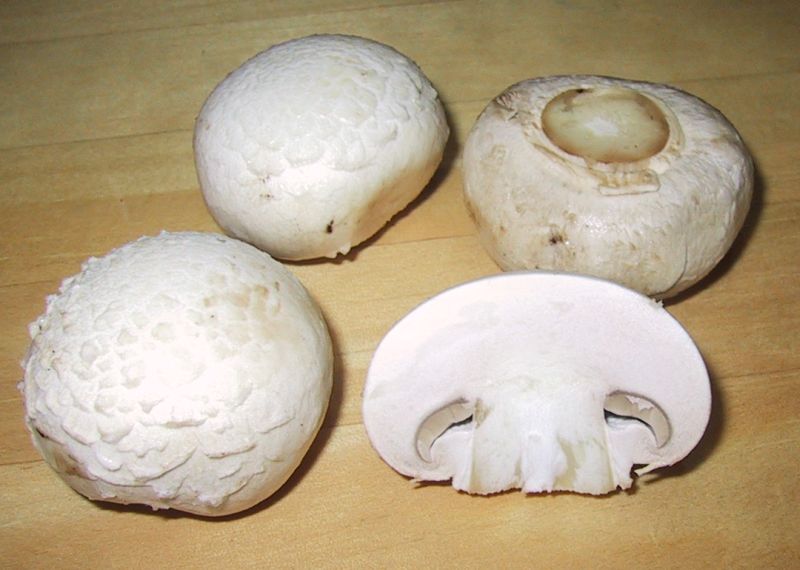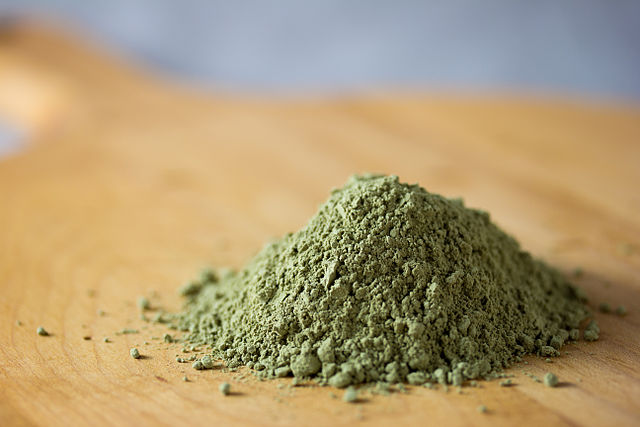Mushroom vs. Tea Powder
Nutrition comparison of Mushroom and Tea Powder
Ever wonder how your favorite foods stack up against each other in terms of nutrition?
We compared the nutritional contents of
mushroom
versus
tea powder
(100g each)
below using 2020 USDA and NIH data[1].
For a quick recap of significant nutrients and differences in mushroom and tea powder:
- Both tea powder and mushroom are high in potassium.
- Mushroom has more thiamin and Vitamin B12, however, tea powder contains more riboflavin, niacin, pantothenic acid, Vitamin B6 and folate.
- Tea powder is a great source of iron.
- Tea powder is an excellent source of calcium, dietary fiber and protein.
USDA sources for nutritional information: Mushroom (Mushrooms, white, raw) and Tea Powder (Beverages, tea, instant, unsweetened, powder) . Have a correction or suggestions? Shoot us an email.
Calories and Carbs
calories
Tea powder is high in calories and mushroom has 93% less calories than tea powder - tea powder has 315 calories per 100 grams and mushroom has 22 calories.
For macronutrient ratios, mushroom is heavier in protein, much lighter in carbs and heavier in fat compared to tea powder per calorie. Mushroom has a macronutrient ratio of 44:47:10 and for tea powder, 26:74:0 for protein, carbohydrates and fat from calories.
Macro Ratios from Calories:
| Mushroom | Tea Powder | |
|---|---|---|
| Protein | 44% | 26% |
| Carbohydrates | 47% | 74% |
| Fat | 10% | ~ |
| Alcohol | ~ | ~ |
carbohydrates
Tea powder is high in carbohydrates and mushroom has 94% less carbohydrates than tea powder - tea powder has 58.7g of total carbs per 100 grams and mushroom has 3.3g of carbohydrates.
dietary fiber
Tea powder is an excellent source of dietary fiber and it has 750% more dietary fiber than mushroom - tea powder has 8.5g of dietary fiber per 100 grams and mushroom has 1g of dietary fiber.
sugar
Tea powder and mushroom contain similar amounts of sugar - tea powder has 5.5g of sugar per 100 grams and mushroom has 2g of sugar.
Protein
protein
Tea powder is an excellent source of protein and it has 554% more protein than mushroom - tea powder has 20.2g of protein per 100 grams and mushroom has 3.1g of protein.
Fat
saturated fat
Both mushroom and tea powder are low in saturated fat - mushroom has 0.05g of saturated fat per 100 grams and tea powder does not contain significant amounts.
Vitamins
Vitamin C
Mushroom has more Vitamin C than tea powder - mushroom has 2.1mg of Vitamin C per 100 grams and tea powder does not contain significant amounts.
Vitamin D
Mushroom has more Vitamin D than tea powder - mushroom has 7iu of Vitamin D per 100 grams and tea powder does not contain significant amounts.
Vitamin E
Mushroom and tea powder contain similar amounts of Vitamin E - mushroom has 0.01mg of Vitamin E per 100 grams and tea powder does not contain significant amounts.
The B Vitamins
Mushroom has more thiamin and Vitamin B12, however, tea powder contains more riboflavin, niacin, pantothenic acid, Vitamin B6 and folate.
| Mushroom | Tea Powder | |
|---|---|---|
| Thiamin | 0.081 MG | ~ |
| Riboflavin | 0.402 MG | 0.985 MG |
| Niacin | 3.607 MG | 10.8 MG |
| Pantothenic acid | 1.497 MG | 4.53 MG |
| Vitamin B6 | 0.104 MG | 0.356 MG |
| Folate | 17 UG | 103 UG |
| Vitamin B12 | 0.04 UG | ~ |
Minerals
calcium
Tea powder is an excellent source of calcium and it has 38 times more calcium than mushroom - tea powder has 118mg of calcium per 100 grams and mushroom has 3mg of calcium.
iron
Tea powder is a great source of iron and it has 352% more iron than mushroom - tea powder has 2.3mg of iron per 100 grams and mushroom has 0.5mg of iron.
potassium
Both tea powder and mushroom are high in potassium. Tea powder has 17 times more potassium than mushroom - tea powder has 6040mg of potassium per 100 grams and mushroom has 318mg of potassium.
Omega-3 and Omega-6
omega 6s
Comparing omega-6 fatty acids, mushroom has more linoleic acid than tea powder per 100 grams.
| Mushroom | Tea Powder | |
|---|---|---|
| linoleic acid | 0.16 G | 0.04 G |
| Total | 0.16 G | 0.04 G |
Customize your serving size
The comparison below is by weight, but sometimes 100g isn't that intuitive of a measurement for food. View a custom portion comparison (e.g. cups, oz, package).
You can try adding or subtracting the amount of either Mushroom or Tea Powder .
Note: The specific food items compared are: Mushroom (Mushrooms, white, raw) and Tea Powder (Beverages, tea, instant, unsweetened, powder) .
Mushroom g
()
|
Daily Values (%) |
Tea Powder g
()
|
|||||
|---|---|---|---|---|---|---|---|
| KCAL % |
|
5% | calories | 5% |
|
KCAL % | |
| G % |
|
5% | carbohydrates | 5% |
|
G % | |
| G % |
|
5% | dietary fiber | 5% |
|
G % | |
| G | 5% | sugar | 5% | G | |||
| G % |
|
5% | total fat | 5% |
|
G % | |
| G % |
|
5% | saturated fat | 5% |
|
G % | |
| G | 5% | monounsaturated fat | 5% | G | |||
| G | 5% | polyunsaturated fat | 5% | G | |||
| G | 5% | trans fat | 5% | G | |||
| MG | 5% | cholesterol | 5% | MG | |||
| MG % |
|
5% | sodium | 5% |
|
MG % | |
| 5% | Vitamins and Minerals | 5% | |||||
| UG % |
|
5% | Vitamin A | 5% |
|
UG % | |
| MG % |
|
5% | Vitamin C | 5% |
|
MG % | |
| IU % |
|
5% | Vitamin D | 5% |
|
IU % | |
| MG % |
|
5% | calcium | 5% |
|
MG % | |
| MG % |
|
5% | iron | 5% |
|
MG % | |
| MG % |
|
5% | magnesium | 5% |
|
MG % | |
| MG % |
|
5% | potassium | 5% |
|
MG % | |
| MG % |
|
5% | thiamin (Vit B1) | 5% |
|
MG % | |
| MG % |
|
5% | riboflavin (Vit B2) | 5% |
|
MG % | |
| MG % |
|
5% | niacin (Vit B3) | 5% |
|
MG % | |
| MG % |
|
5% | Vitamin B6 | 5% |
|
MG % | |
| MG % |
|
5% | pantothenic acid (Vit B5) | 5% |
|
MG % | |
| UG % |
|
5% | folate (Vit B9) | 5% |
|
UG % | |
| UG % |
|
5% | Vitamin B12 | 5% |
|
UG % | |
| MG % |
|
5% | Vitamin E | 5% |
|
MG % | |
| UG % |
|
5% | Vitamin K | 5% |
|
UG % | |
| G % |
|
5% | protein | 5% |
|
G % | |
| UG % |
|
5% | biotin (Vit B7) | 5% |
|
UG % | |
| MG % |
|
5% | choline | 5% |
|
MG % | |
| MG % |
|
5% | chlorine | 5% |
|
MG % | |
| UG % |
|
5% | chromium | 5% |
|
UG % | |
| MG % |
|
5% | copper | 5% |
|
MG % | |
| UG % |
|
5% | fluoride | 5% |
|
UG % | |
| UG % |
|
5% | iodine | 5% |
|
UG % | |
| MG % |
|
5% | manganese | 5% |
|
MG % | |
| UG % |
|
5% | molybdenum | 5% |
|
UG % | |
| MG % |
|
5% | phosphorus | 5% |
|
MG % | |
| UG % |
|
5% | selenium | 5% |
|
UG % | |
| MG % |
|
5% | zinc | 5% |
|
MG % | |
| G | 5% | Water | 5% | G | |||
| G | 5% | Starch | 5% | G | |||
| G | 5% | Alcohol | 5% | G | |||
FAQ
Does tea powder or mushroom contain more calories in 100 grams?Tea powder is high in calories and mushroom has 90% less calories than tea powder - tea powder has 315 calories in 100g and mushroom has 22 calories.
Is tea powder or mushroom better for protein?
Tea powder is a fantastic source of protein and it has 550% more protein than mushroom - tea powder has 20.2g of protein per 100 grams and mushroom has 3.1g of protein.
Does tea powder or mushroom have more carbohydrates?
By weight, tea powder is high in carbohydrates and mushroom has 90% fewer carbohydrates than tea powder - tea powder has 58.7g of carbs for 100g and mushroom has 3.3g of carbohydrates.
Does tea powder or mushroom contain more calcium?
Tea powder is a rich source of calcium and it has 38 times more calcium than mushroom - tea powder has 118mg of calcium in 100 grams and mushroom has 3mg of calcium.
Does tea powder or mushroom contain more potassium?
Both tea powder and mushroom are high in potassium. Tea powder has 17 times more potassium than mushroom - tea powder has 6040mg of potassium in 100 grams and mushroom has 318mg of potassium.

